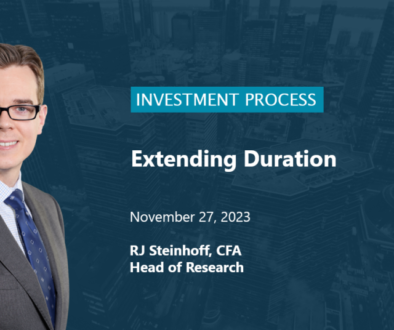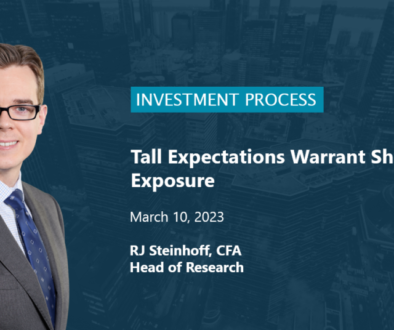Accounting for Interest Rates
RJ Steinhoff, CFA Investment Process
The S&P 500 is trading near all-time high valuation metrics, only eclipsed by the dot-com bubble (1998 – 2001) and periods where multiples rose dramatically because earnings collapsed (e.g., during depressions or deep recessions such as 1921, the 1930s, early 90s, and the Great Recession of 2008).
Some argue that the major market indices are not as expensive as their multiples suggest because interest rates are so low. A widely held belief is that lower interest rates translate to multiple expansion. On the face of it, this argument makes sense since low rates means low inflation expectations and a lower risk-free rate to discount future expected earnings. Table 1 demonstrates that historically there has been a negative relationship between interest rates and prevailing price-to-earnings (P/E) multiples.
Table 1. Historical Average Month-End P/E Multiples at 1% 10 Year Treasury Intervals Since 1953
| 10-Year Treasury Rate | S&P 500 P/E Multiple |
|---|---|
| < 2% | 19.9x |
| 2 – 3% | 19.6x |
| 3 – 4% | 23.8x |
| 4 – 5% | 20.6x |
| 5 – 6% | 23.9x |
| 6 – 7% | 19.3x |
| 7 – 8% | 14.3x |
| 8 – 9% | 13.5x |
| 9 – 10% | 11.7x |
| 10 – 11% | 10.6x |
| 11 – 12% | 10.7x |
| 12 – 13% | 9.2x |
| 13 – 14% | 8.4x |
| > 14% | 8.1x |
SOURCES: FACTSET, QUANDL, GENERATION IACP INC.
However, Table 1 also reveals the relationship between interest rates and P/E multiples becomes less clear when rates fall below 5%. For example, P/E multiples have been higher when rates have ranged between 4 to 5% than below 2% (during the dot-com bubble the 10-year treasury ranged between 3.5% and 6.5%). The reality is that interest rates are just one of many variables that drives valuation, along with growth and inflation expectations, tax policy, demographics, commodity prices, currency movements, geopolitical uncertainty, and technological disruption. These variables interact non-linearly which makes forecasting their future direction all but impossible (sorry market prognosticators).
IMPLIED GROWTH
We can attempt to incorporate interest rates into market valuation by examining implied growth. The implied growth calculation flips the typical valuation equation (i.e., discounting earnings or cash flows) on its head, setting valuation at current market prices and then solving for the growth rate. In our approach, we use normalized earnings as a proxy for cash flows. Each company’s cost of equity is calculated using trailing three-year betas and the 10-year Treasury rate for the risk-free rate.
Chart 1 shows that median implied growth expectations for the S&P 500 constituents is near peak levels, in agreement with valuation multiples.
CHART 1. Median Implied Growth for S&P 500 Constituents, June 2000 to January 22, 2019
SOURCES: FACTSET, GENERATION IACP INC.
We see little margin of safety for the broader markets at current levels. Valuation is one of several reasons we have initiated market hedges for long/short strategies while we continue to hunt for undervalued, high quality companies.

RJ Steinhoff, CFA
Director of Research
DISCLAIMER
The information contained herein is for informational and reference purposes only and shall not be construed to constitute any form of investment advice. Nothing contained herein shall constitute an offer, solicitation, recommendation or endorsement to buy or sell any security or other financial instrument. Investment accounts and funds managed by Generation IACP Inc. may or may not continue to hold any of the securities mentioned. Generation IACP Inc., its affiliates and/or their respective officers, directors, employees or shareholders may from time to time acquire, hold or sell securities mentioned.
The information contained herein may change at any time and we have no obligation to update the information contained herein and may make investment decisions that are inconsistent with the views expressed in this presentation. It should not be assumed that any of the securities transactions or holdings mentioned were or will prove to be profitable, or that the investment decisions we make in the future will be profitable or will equal the investment performance of the securities mentioned. Past performance is no guarantee of future results and future returns are not guaranteed.
The information contained herein does not take into consideration the investment objectives, financial situation or specific needs of any particular person. Generation IACP Inc. has not taken any steps to ensure that any securities or investment strategies mentioned are suitable for any particular investor. The information contained herein must not be used, or relied upon, for the purposes of any investment decisions, in substitution for the exercise of independent judgment. The information contained herein has been drawn from sources which we believe to be reliable; however, its accuracy or completeness is not guaranteed. We make no representation or warranties as to the accuracy, completeness or timeliness of the information, text, graphics or other items contained herein. We expressly disclaim all liability for errors or omissions in, or the misuse or misinterpretation of, any information contained herein.
All products and services provided by Generation IACP Inc. are subject to the respective agreements and applicable terms governing their use. The investment products and services referred to herein are only available to investors in certain jurisdictions where they may be legally offered and to certain investors who are qualified according to the laws of the applicable jurisdiction. Nothing herein shall constitute an offer or solicitation to anyone in any jurisdiction where such an offer or solicitation is not authorized or to any person to whom it is unlawful to make such a solicitation.
The S&P 500 is trading near all-time high valuation metrics, only eclipsed by the dot-com bubble (1998 – 2001) and periods where multiples rose dramatically because earnings collapsed (e.g., during depressions or deep recessions such as 1921, the 1930s, early 90s, and the Great Recession of 2008).
Some argue that the major market indices are not as expensive as their multiples suggest because interest rates are so low. A widely held belief is that lower interest rates translate to multiple expansion. On the face of it, this argument makes sense since low rates means low inflation expectations and a lower risk-free rate to discount future expected earnings. Table 1 demonstrates that historically there has been a negative relationship between interest rates and prevailing price-to-earnings (P/E) multiples.
Table 1. Historical Average Month-End P/E Multiples at 1% 10 Year Treasury Intervals Since 1953
| 10-Year Treasury Rate | S&P 500 P/E Multiple |
|---|---|
| < 2% | 19.9x |
| 2 – 3% | 19.6x |
| 3 – 4% | 23.8x |
| 4 – 5% | 20.6x |
| 5 – 6% | 23.9x |
| 6 – 7% | 19.3x |
| 7 – 8% | 14.3x |
| 8 – 9% | 13.5x |
| 9 – 10% | 11.7x |
| 10 – 11% | 10.6x |
| 11 – 12% | 10.7x |
| 12 – 13% | 9.2x |
| 13 – 14% | 8.4x |
| > 14% | 8.1x |
SOURCES: FACTSET, QUANDL, GENERATION IACP INC.
However, Table 1 also reveals the relationship between interest rates and P/E multiples becomes less clear when rates fall below 5%. For example, P/E multiples have been higher when rates have ranged between 4 to 5% than below 2% (during the dot-com bubble the 10-year treasury ranged between 3.5% and 6.5%). The reality is that interest rates are just one of many variables that drives valuation, along with growth and inflation expectations, tax policy, demographics, commodity prices, currency movements, geopolitical uncertainty, and technological disruption. These variables interact non-linearly which makes forecasting their future direction all but impossible (sorry market prognosticators).
IMPLIED GROWTH
We can attempt to incorporate interest rates into market valuation by examining implied growth. The implied growth calculation flips the typical valuation equation (i.e., discounting earnings or cash flows) on its head, setting valuation at current market prices and then solving for the growth rate. In our approach, we use normalized earnings as a proxy for cash flows. Each company’s cost of equity is calculated using trailing three-year betas and the 10-year Treasury rate for the risk-free rate.
Chart 1 shows that median implied growth expectations for the S&P 500 constituents is near peak levels, in agreement with valuation multiples.
CHART 1. Median Implied Growth for S&P 500 Constituents, June 2000 to January 22, 2019
SOURCES: FACTSET, GENERATION IACP INC.
We see little margin of safety for the broader markets at current levels. Valuation is one of several reasons we have initiated market hedges for long/short strategies while we continue to hunt for undervalued, high quality companies.
DISCLAIMER
The information contained herein is for informational and reference purposes only and shall not be construed to constitute any form of investment advice. Nothing contained herein shall constitute an offer, solicitation, recommendation or endorsement to buy or sell any security or other financial instrument. Investment accounts and funds managed by Generation IACP Inc. may or may not continue to hold any of the securities mentioned. Generation IACP Inc., its affiliates and/or their respective officers, directors, employees or shareholders may from time to time acquire, hold or sell securities mentioned.
The information contained herein may change at any time and we have no obligation to update the information contained herein and may make investment decisions that are inconsistent with the views expressed in this presentation. It should not be assumed that any of the securities transactions or holdings mentioned were or will prove to be profitable, or that the investment decisions we make in the future will be profitable or will equal the investment performance of the securities mentioned. Past performance is no guarantee of future results and future returns are not guaranteed.
The information contained herein does not take into consideration the investment objectives, financial situation or specific needs of any particular person. Generation IACP Inc. has not taken any steps to ensure that any securities or investment strategies mentioned are suitable for any particular investor. The information contained herein must not be used, or relied upon, for the purposes of any investment decisions, in substitution for the exercise of independent judgment. The information contained herein has been drawn from sources which we believe to be reliable; however, its accuracy or completeness is not guaranteed. We make no representation or warranties as to the accuracy, completeness or timeliness of the information, text, graphics or other items contained herein. We expressly disclaim all liability for errors or omissions in, or the misuse or misinterpretation of, any information contained herein.
All products and services provided by Generation IACP Inc. are subject to the respective agreements and applicable terms governing their use. The investment products and services referred to herein are only available to investors in certain jurisdictions where they may be legally offered and to certain investors who are qualified according to the laws of the applicable jurisdiction. Nothing herein shall constitute an offer or solicitation to anyone in any jurisdiction where such an offer or solicitation is not authorized or to any person to whom it is unlawful to make such a solicitation.



